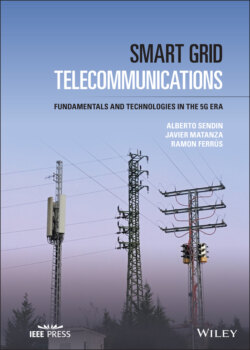Читать книгу Smart Grid Telecommunications - Ramon Ferrús - Страница 47
1.6.8 Resilient Telecommunication Networks and Services
ОглавлениеTwo different concepts mix when referring to resiliency in telecommunications: reliability and resiliency. Before we refer to them, we need first to focus our attention on the availability concept, prevalent in the measurement of the service conditions.
Availability is defined in ITU‐T E.800 as the ability “of an item to be in the state to perform a required function at a given instant of time or at any instant of time within a given time interval, assuming that the external resources, if required, are provided.” When the network is available, its performance can be observed and measured. Many ITU‐T and ITU‐R recommendations define availability objectives. Few references, however, exist for Smart Grid‐related telecommunication services, although it can be broadly assumed that the strictest Smart Grid services need 99.999% availability (this means 315.36 seconds of unavailability during the year).
To have networks and services in the “available” state, reliability concept appears. It is defined in ITU‐T E.800 as “the probability that an item can perform a required function under stated conditions for a given time interval.” Reliability is different to resiliency. Resiliency can be defined as “the ability of an entity, system, network or service to resist the effects of a disruptive event, or to recover from the effects of a disruptive event to a normal or near‐normal state” [62]. Thus, while reliability focuses on preventing that the system fails, resilience focuses on recovering when it fails.
Resilience in telecommunications implies carrier‐grade (carrier‐class) network elements (equipment with redundancy in its vital parts – such as power supply), reliable design of network links (with the proper availability assurance), protection of paths through redundant routes that will not fail simultaneously, licensed spectrum usage (legally protected not be interfered), battery backup, etc. While these elements can be properly controlled in private networks, it can just be controlled through SLAs in commercial services.
Finally, security or cybersecurity aspects need to be mentioned. Security aspects must be considered even if only related to the availability of networks, as attacks can turn any network or service into either a non‐performing one or a non‐available one (e.g., denial‐of‐service [63]). As an example of this importance, North American Electric Reliability Corporation (NERC) has developed and enforced regulations that demonstrate the importance of security in electric utilities. Security is not just an add‐on of telecommunication networks, but a by‐design aspect that needs to be present at any stage of the telecommunication service and its network components (technology definition, products implementation, deployment, operations, and delivery).
